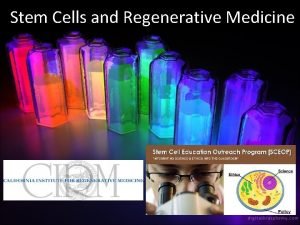Institute for Regenerative Medicine Chemokine Regenerative Therapy for

- Slides: 1

Institute for Regenerative Medicine Chemokine Regenerative Therapy for Chronic Fibrotic Kidney Disease: Translational Studies Julie Bennington, DVM; Shannon Lankford, RLATg; Renata Magalhaes, MD, Ph. D; Douglas Shankle; Jason Fanning, Ph. D; Cucu Kartini, DVM; Irma Suparto, MD, Ph. D; Winda Kusumawardhani, DVM; M Ar. Raniri Putra, DVM; Silmi Mariya, Ph. D; Gopal Badlani, MD; J Koudy Williams, DVM Chronic Kidney Disease (CKD) is a common, progressive disease that afflicts both human and veterinary patients with a higher prevalence in women than men. The underlying pathology is chronic tubule-interstitial fibrosis, irreversible, and has no cure. There is a marked shortage of transplantable kidneys. Widespread clinical use of tissue engineered kidneys or cell therapy for CKD is years in the future. The goal of this study is to test the use of the cell-signaling chemokine CXCL 12 on restoration of kidney structure and function in both a preclinical cat model of renal fibrosis and in a pilot study using cats with naturally-occurring CKD. 30 adult female cats with established unilateral ischemia/reperfusion (I/R) - induced renal fibrosis were used to test the effects of intra-renal injection of 100, 200, or 400 ng (n=6/dose) of CXCL 12 on renal fibrosis in the affected kidney. Baseline blood/urine renal function tests were performed at the time of I/R Injury, Day 42, Day 70 (Treatment Injection), and then monthly for 4 months post-injection. Necropsies were performed and tissues harvested for histological evaluation. Clinical Pilot Study 14 cats with naturally-occurring clinical Stage 1 -2 CKD were divided into Control vs. Treatment group (n=7/group). Treated cats received the 200 ng dose of CXCL 12 in both kidneys using ultrasound guidance. Baseline blood/urine renal tests were performed prior to injections and repeated monthly for 12 months. CKD staging, serum creatinine, SDMA (symmetric dimethylarginine), and USG were measured. Design & Timeline Preclinical Cat Model of I/R-induced Renal Fibrosis Preclinical Study Introduction Table Summary of CKD Stage Progression (# of Cats) Worse Control 4 No Change 0 Treatment 0 4 Improved 3 3 Pilot Study Results Bilateral intra-renal injection of CXCL 12 using ultrasound guidance in cats with CKD was feasible and safe in a general practice clinical setting with no obvious side effects noted during the follow-up period. Preclinical Study Results I/R increased collagen content and increased collagen fiber width in the affected kidney. Both the mid and high doses of CXCL 12 restored kidney collagen content and collagen fiber width in the I/R kidney (p<0. 05 vs. untreated). Because only one kidney was damaged, only minimal changes could be detected in BUN, creatinine, or urine specific gravity (USG) (p>0. 05). Overall Conclusions Acknowledgements: Wake Forest Institute for Regeneration Medicine Dr. Bennington was supported by the NIH Postdoctoral T 32 Institutional Training Grant “Laboratory Animal and Comparative Medicine Research” (NIH T 32 OD 010957) from 2017 -2020. This study was funded by Piedmont Animal Health, Greensboro, NC. Including excerpts from Bennington J, Lankford S, Magalhaes RS, et al. Chemokine Therapy in Cats With Experimental Renal Fibrosis and in a Kidney Disease Pilot Study. Frontiers in Veterinary. Science. 2021; 8(199).

